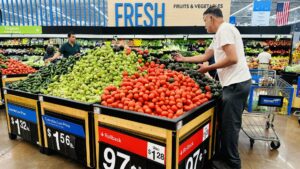Price Increases Looming: What Walmart’s Tariff Challenges Mean for Consumers
As we move further into 2023, price increases are on the horizon for shoppers at Walmart. The retail giant, synonymous with low prices, is preparing to adjust prices on various goods due to escalating tariffs—a situation that could affect consumers far beyond the aisles of Walmart.
The Tariff Landscape
In a recent announcement, Walmart’s CFO John David Rainey shared critical insights during a CNBC interview. Despite a temporary 90-day reprieve that reduced duties on Chinese imports from 145% to 30%, other products from numerous countries will still incur a 10% duty. This unprecedented landscape of tariffs is forcing Walmart to change its pricing strategy.
"We’re navigating this as best as we can," Rainey remarked, encapsulating the complexity retailers face in the current economic climate. Shoppers can expect to see price hikes starting as early as May, with more substantial markups anticipated by June.
A Ripple Effect on Pricing Across Retail
As the largest grocer and retailer in the U.S., Walmart’s decisions impact a vast network of retailers. Rainey indicated that certain items and categories would be more affected by these tariffs than others. Notably, for every cucumber or toy that is assembled overseas—from places like China, Mexico, and Vietnam—prices might rise due to increased costs.
CEO Doug McMillon elaborated on how tariffs on goods imported from Costa Rica, Peru, and Colombia have already heightened the cost of staples such as bananas, avocados, and even coffee.
How Walmart is Adapting
Walmart isn’t standing still. The company has proactively sought to minimize tariff exposure and manage its inventory effectively despite unpredictable tariff rates. By reassessing their product sourcing—shifting from materials like aluminum to alternatives such as fiberglass—they aim to mitigate rising costs while providing customers with value.
Rainey also disclosed that Walmart is strategically reducing order sizes for items expected to face prohibitive price increases. This not only helps manage supply but also aligns with predicted consumer behavior—less stocking of goods that may soon be priced out of reach.
Consumer Behavior: A Double-edged Sword
Interestingly, these price changes might bring both challenges and opportunities. As consumers brace for hikes, we’re seeing a trend where they rush to purchase big-ticket items like cars, yet hesitate to spend on everyday purchases. This dichotomy poses a unique challenge for retailers as they strive to balance their inventory while predicting customer demand for peak shopping seasons, such as back-to-school and the holidays.
However, this environment could also favor Walmart, as consumers typically seek value during price increases. Rainey stated, “There might be areas where we want to be more aggressive,” suggesting that even if it means sacrificing short-term profits, the long-term gain could be substantial.
Competitive Pricing Strategy
Walmart is determined to maintain its cost advantage, even if it has to adjust profit margins. The company’s commitment to keeping price gaps with competitors remains unchanged, ensuring that it continues to be the go-to destination for value-conscious shoppers.
In this ever-evolving retail landscape, Walmart’s nimbleness could make it a preferred choice for many consumers looking to maximize their purchasing power.
Conclusion
As we navigate through the complexities of tariffs and price adjustments, it’s essential for consumers to stay informed. At Extreme Investor Network, we recognize the challenges that these economic conditions can impose on everyday spending. While price increases loom, understanding the strategic movements of major retailers can empower you to make better choices in your shopping habits.
For more insights on guiding your investments in today’s market, stay tuned to our updates at Extreme Investor Network—your trusted source for navigating the business landscape.

